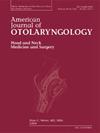与气管食管假体并发症相关的患者因素:一项回顾性TriNetX研究
IF 1.7
4区 医学
Q2 OTORHINOLARYNGOLOGY
引用次数: 0
摘要
气管食管穿刺加假声是全喉切除术(TL)后常见的语音修复方法。本研究旨在确定除TEP相关并发症外,与TEP需要更频繁的更换和维持相关的患者因素。方法在TriNetX研究网络中识别行TEP手术的患者。根据合并症对队列进行分层,包括糖尿病、胃食管反流、食管狭窄、甲状腺功能减退/亢进、吸烟和饮酒、放射史以及原发性与继发性TEP。Kaplan-Meier分析评估了更换假体的时间,并计算了并发症的风险,包括瘘管形成、局部感染、假体泄漏、吸入性肺炎和吞咽困难。结果在4145例患者中,糖尿病与假体泄漏和吞咽困难的风险增加有关。甲状腺功能减退、胃食管反流和食管狭窄与瘘管形成、感染、假体泄漏、吸入性肺炎和吞咽困难的发生率较高有关。与继发性TEP相比,原发性TEP与瘘和感染率增加有关。辐射和烟草使用与吞咽困难显著相关,烟草和酒精使用与感染和误吸风险较高相关。到TEP改变的平均时间为72天。胃食管反流(HR 1.17, 95% CI[1.06-1.29])和食管狭窄(HR 1.13, 95% CI[1.02-1.26])患者需要更频繁地更换假体。结论了解影响TEP功能和寿命的因素有助于优化患者在TL后TEP的选择。并发症风险增加导致需要更频繁TEP改变的患者在讨论TL后发声选择时应仔细咨询。本文章由计算机程序翻译,如有差异,请以英文原文为准。
Patient factors associated with tracheoesophageal prosthesis complications: A retrospective TriNetX study
Introduction
Tracheoesophageal puncture (TEP) with voice prothesis placement is a common method for voice restoration following total laryngectomy (TL). This study aims to determine patient factors associated with the need for more frequent TEP changes and maintenance in addition to TEP-associated complications.
Methods
Patients who underwent TEP procedure were identified in the TriNetX Research Network. Cohorts were stratified by comorbidities, including diabetes, GERD, esophageal stricture, hypo/hyperthyroidism, tobacco and alcohol use, radiation history, and primary versus secondary TEP. Kaplan-Meier analyses assessed time to prosthesis change, and risks of complications, including fistula formation, local infection, prosthesis leak, aspiration pneumonia, and dysphagia, were calculated.
Results
Among 4145 patients identified, diabetes was associated with increased risk of prosthesis leak and dysphagia. Hypothyroidism, GERD, and esophageal strictures were linked to higher rates of fistula formation, infection, prosthesis leak, aspiration pneumonia, and dysphagia. Primary TEP was associated with increased fistula and infection rates compared to secondary TEP. Radiation and tobacco use were significantly associated with dysphagia, and tobacco and alcohol use with higher infection and aspiration risks. Average time to TEP change was 72 days. Patients with GERD (HR 1.17, 95 % CI [1.06–1.29]) and esophageal stricture (HR 1.13, 95 % CI [1.02–1.26]) required more frequent prosthesis changes.
Conclusions
Understanding factors that affect TEP function and longevity can help optimize patient selection for TEP following TL. Patients at increased risk for complications resulting in the need for more frequent TEP changes should be carefully counseled during the discussion of voicing options following TL.
求助全文
通过发布文献求助,成功后即可免费获取论文全文。
去求助
来源期刊

American Journal of Otolaryngology
医学-耳鼻喉科学
CiteScore
4.40
自引率
4.00%
发文量
378
审稿时长
41 days
期刊介绍:
Be fully informed about developments in otology, neurotology, audiology, rhinology, allergy, laryngology, speech science, bronchoesophagology, facial plastic surgery, and head and neck surgery. Featured sections include original contributions, grand rounds, current reviews, case reports and socioeconomics.
 求助内容:
求助内容: 应助结果提醒方式:
应助结果提醒方式:


